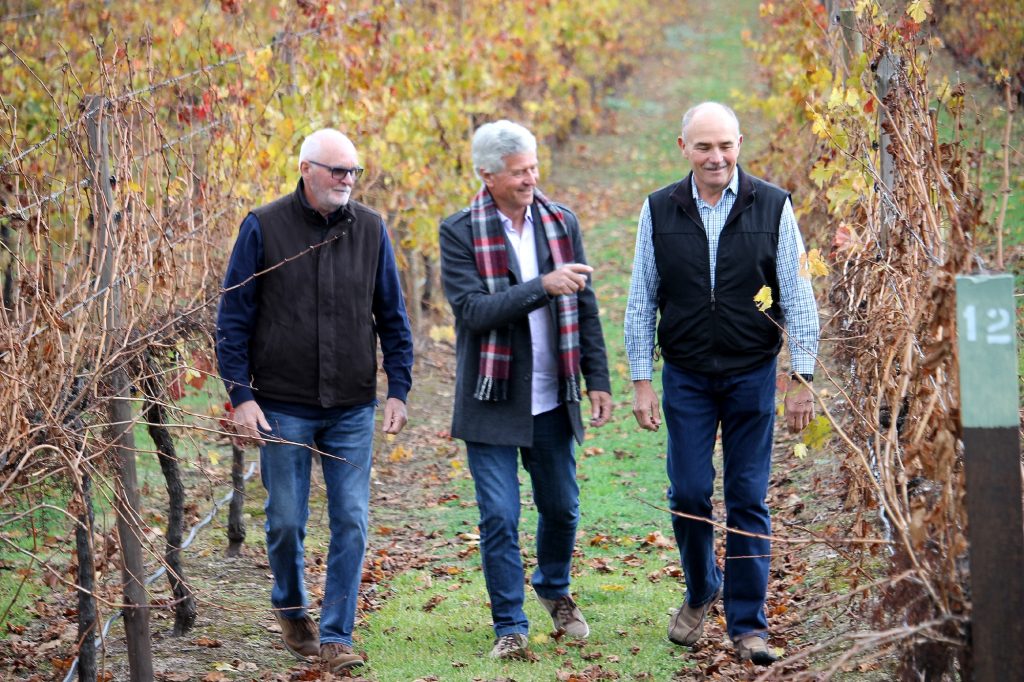Image: Gapsted Wines founders (from left) John Cavedon, Pat Murtagh and Shayne Cunningham are ready to hand the business over to new owners. Credit: Laurie Sullivan
By Anita McPherson, North East Media
One of North East Victoria’s largest, multi-faceted wine businesses, a prominent feature on the local landscape, has hit the open market.
Gapsted Wines near Myrtleford is for sale, with the managing agent describing it as an opportunity to acquire a profitable turn-key operation with substantial production capacity.
Established in 1997, Gapsted Wines was built by a group of independent grape growers from the Alpine and King valleys.
A spokesperson for the company said the operation was originally conceived as a contract processing facility, and gradually evolved over the last 24 years to become a diverse, strongly-branded business.
“The partners stated that as they are now nearing retirement age and with no family members to step in, they are seeking expressions of interest to acquire the business and assets as a going concern,” he said.
“It is the current owners’ desire that a new owner will develop the winery, further enhance its reputation and cater for all current employees while potentially providing more opportunity for employment in the area.”
The three founding members of Gapsted Wines, which began life as Victorian Alps Wine Company, still make up the board.
They include Shayne Cunningham, currently a non-executive director who was the first CEO/chief winemaker and held the role until his retirement six years ago.
Also a founding member, Pat Murtagh is currently chairman of the board and also a supplier of grapes to the company.
Rounding out the three is John Cavedon, currently a non-executive director and until recently grape liaison officer and also a supplier of grapes to the winery.
When the winery commenced operations in 1997 it had a staff of five which has grown to 35 permanent staff members today, rising to 55 during vintage.
Recognisable on the landscape, it has a cellar door and restaurant and is situated on 24 hectares of land with eight hectares under vines used in their own branded product.
The winery itself has an 8000 tonne crush capacity and 8.2 million litres of stainless steel storage, plus an 1800 square metre insulated warehouse and barrel store.
The spokesperson said over the years the winery has developed a diverse portfolio of brands, is a supplier of private labels for key retailers, has a thriving cellar door and a substantial and growing wine club.
He said the partners look forward to seeing new owners take the winery to the next level and continue to play an important role in the Alpine Valleys wine region.
Quality production key focus in Alpine Valley
Member and former president of Alpine Valley Vignerons, Michael Freudenstein, said Gapsted Wines was the largest winery in the region, sourced fruit from the area and was an integral part of the local tourism structure.
He said while last year more than 90 per cent of vintage in the region was lost due the impact of smoke from the 2019/2020 bushfires, this year was a great success and the future outlook for the region was positive.
“What we have done over the last 10 years is to reduce quantities and started to produce quality,” he said.
“Now a lot more of the grapes grown in the Alpine Valleys are used by winemakers within the Alpine Valleys (rather than being shipped all over the country) so it has become a quality wine producing region rather than a grape producing region.”
Mr Freudenstein said the cool climate region was also recognised as being less impacted by climate change and rising temperatures, although it still suffered from the effects.
“As time has gone on, all the growers in the region have planted varieties that coped with that change and are now producing varieties and wine that is better suited to this region,” he said.
“We’ve got to be aware that because of climate change, bushfires are going to become a more regular event and we have to get a lot smarter in how we deal with that.
“The technology is now improving to the extent where bushfire doesn’t mean total destruction – there are things you can do to make some wine – but we’ve also got to realise that in the years where you do get smoke taint, you just don’t.
“The research that has been done over the last five years has been phenomenal.
“There are advances in technology now, not only in recognising smoke taint levels, but also in preventative measures and during the winemaking process – there are processes you can use to minimise the impact.”
Are you a Daily Wine News subscriber? If not, click here to join our mailing list. It’s free!





















